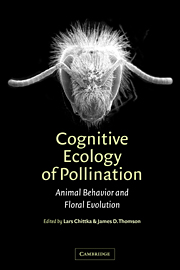Book contents
- Frontmatter
- Contents
- List of contributors
- Preface
- 1 The effect of variation among floral traits on the flower constancy of pollinators
- 2 Behavioral and neural mechanisms of learning and memory as determinants of flower constancy
- 3 Subjective evaluation and choice behavior by nectar-and pollen-collecting bees
- 4 Honeybee vision and floral displays:from detection to close-up recognition
- 5 Floral scent, olfaction, and scent-driven foraging behavior
- 6 Adaptation, constraint, and chance in the evolution of flower color and pollinator color vision
- 7 Foraging and spatial learning in hummingbirds
- 8 Bats as pollinators: foraging energetics and floral adaptations
- 9 Vision and learning in some neglected pollinators: beetles, flies, moths, and butterflies
- 10 Pollinator individuality: when does it matter?
- 11 Effects of predation risk on pollinators and plants
- 12 Pollinator preference, frequency dependence, and floral evolution
- 13 Pollinator-mediated assortative mating: causes and consequences
- 14 Behavioural responses of pollinators to variation in floral display size and their influences on the evolution of floral traits
- 15 The effects of floral design and display on pollinator economics and pollen dispersal
- 16 Pollinator behavior and plant speciation: looking beyond the “ethological isolation” paradigm
- Index
6 - Adaptation, constraint, and chance in the evolution of flower color and pollinator color vision
Published online by Cambridge University Press: 13 August 2009
- Frontmatter
- Contents
- List of contributors
- Preface
- 1 The effect of variation among floral traits on the flower constancy of pollinators
- 2 Behavioral and neural mechanisms of learning and memory as determinants of flower constancy
- 3 Subjective evaluation and choice behavior by nectar-and pollen-collecting bees
- 4 Honeybee vision and floral displays:from detection to close-up recognition
- 5 Floral scent, olfaction, and scent-driven foraging behavior
- 6 Adaptation, constraint, and chance in the evolution of flower color and pollinator color vision
- 7 Foraging and spatial learning in hummingbirds
- 8 Bats as pollinators: foraging energetics and floral adaptations
- 9 Vision and learning in some neglected pollinators: beetles, flies, moths, and butterflies
- 10 Pollinator individuality: when does it matter?
- 11 Effects of predation risk on pollinators and plants
- 12 Pollinator preference, frequency dependence, and floral evolution
- 13 Pollinator-mediated assortative mating: causes and consequences
- 14 Behavioural responses of pollinators to variation in floral display size and their influences on the evolution of floral traits
- 15 The effects of floral design and display on pollinator economics and pollen dispersal
- 16 Pollinator behavior and plant speciation: looking beyond the “ethological isolation” paradigm
- Index
Summary
Anciently the teaching was that nothing would have been created that did not have a definite purpose, and more recently it has been that natural selection would eliminate anything that did not serve an equally definite purpose. … the assumed relation between the colors of flowers and the … pollinating insects is such a classic …
Apparently there is something about the internal mechanism … that makes it difficult for a rose to be blue. … therefore, the use of the idea of natural selection to explain the absence of blue roses in nature is not only not necessary but it is not justified … It would be much better for the rose to be blue.
F. E. Lutz (1924)We commonly think that biological signals and receivers are mutually tuned to one another. Flower colors and pollinator color vision are not exceptions. The diversity of flower colors and the differences in color vision between different classes of pollinators make speculations about their mutual adaptation tempting. Yet close inspection reveals that we know very little about evolutionary changes in flower color induced by selection pressures related to pollination, nor is there much evidence to show that color vision systems of pollinators have been tuned to flower color. We shall review cases where we think such changes have occurred, and other cases where they have not, even where a purely adaptationist scenario would predict evolutionary tuning.
- Type
- Chapter
- Information
- Cognitive Ecology of PollinationAnimal Behaviour and Floral Evolution, pp. 106 - 126Publisher: Cambridge University PressPrint publication year: 2001
- 99
- Cited by



